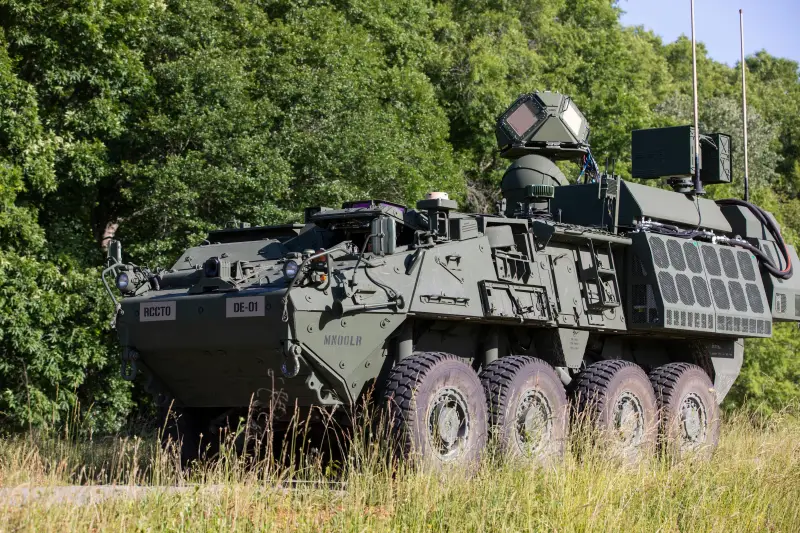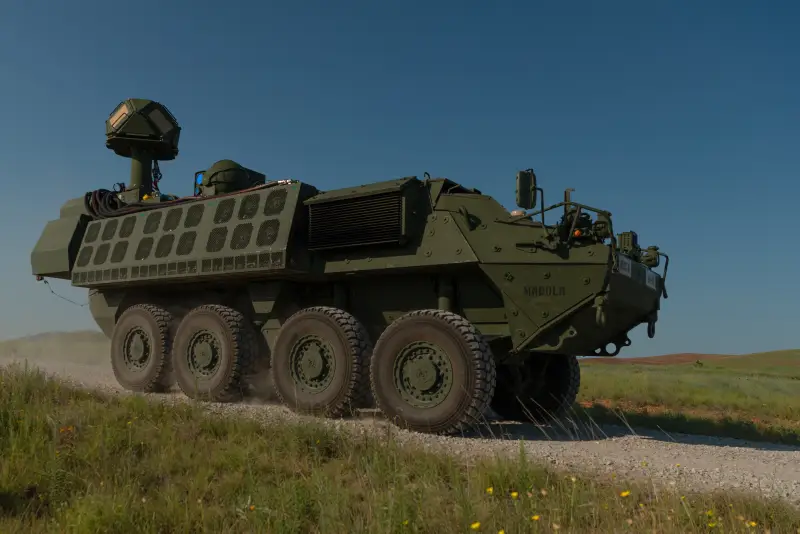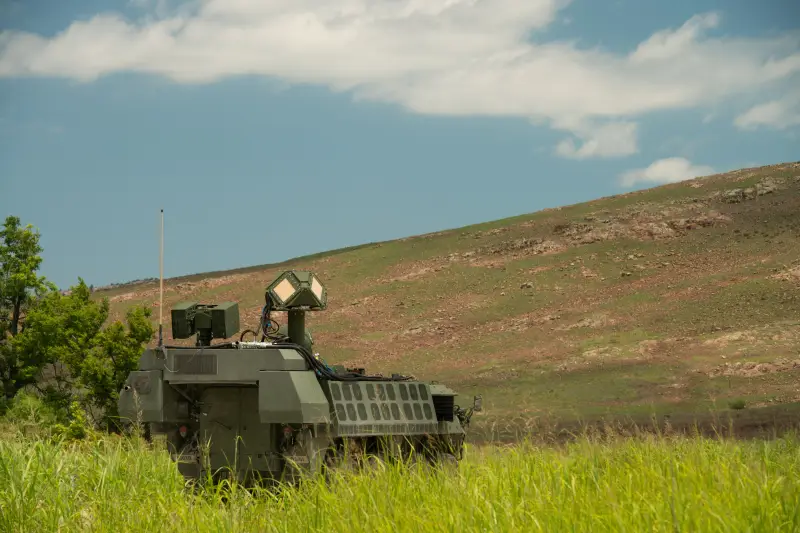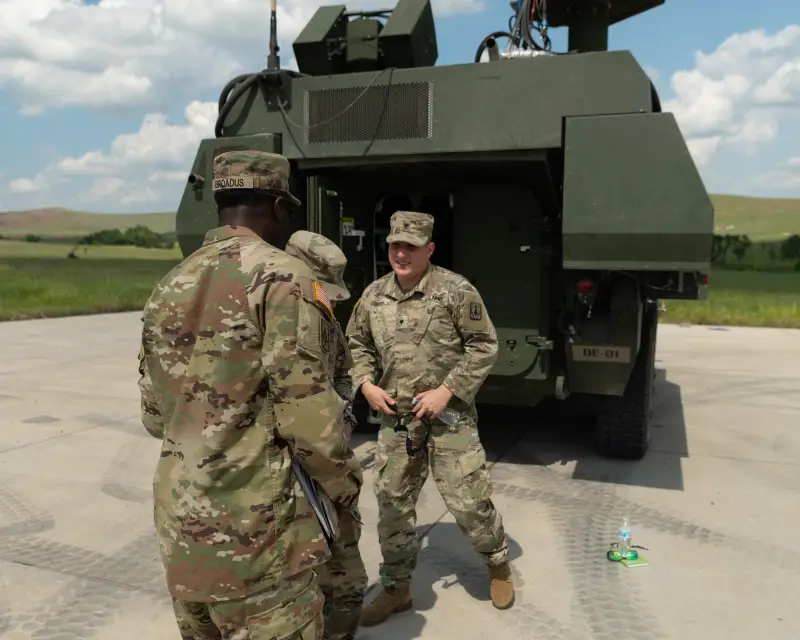Anti-aircraft laser complex DE M-SHORAD at the testing stage

ZLK DE M-SHORAD in the early stages of testing
Since the end of the last decade, the Pentagon and its contractors have been working on a project for the advanced anti-aircraft laser system DE M-SHORAD. To date, they have completed the development of a new combat vehicle and put it through several stages of verification. Currently, military tests are being carried out on the basis of one of the combat units, and recently several laser self-propelled guns arrived in Iraq, where they must show their potential in conditions as close as possible to real operation and combat use.
From design to testing
The development of Direct Energy Maneuver Short-Range Air Defense (DE M-SHORAD) began in 2019 at the initiative of the Pentagon. The goal of the project was to create an anti-aircraft laser complex (ZLK) on the chassis of a Stryker armored personnel carrier with a 50 kW emitter. With the help of such equipment, in the future they planned to strengthen the military air defense of the army.
Raytheon (now RTX) and Northrop Grumman took part in the competitive part of the program. At the end of 2020, they built and presented experimental equipment of their development for testing. Comparative tests continued for several months, after which Northrop-Grumman withdrew from the project. American media reported that this was due to design flaws in the combat laser, which led to overheating and even fire.
Soon, RTX became the official winner of the competition and received a contract to continue the work. According to the terms of the document, in 2022-23. she was supposed to assemble and transfer to the Pentagon a batch of four DE M-SHORAD products for military testing. Another such batch was expected to be delivered in 2024 to expand the testing and inspection program.
The first pre-production products for military testing were handed over to the customer at the beginning of 2023. A year ago, in April, the first combat training firing took place at the Yuma training ground (Arizona) as part of a new stage of testing. Subsequently, the army received the remaining ZLKs of the first batch and continued extensive testing.

Latest news
On March 1, the American publication Breaking Defense published new information about the work on DE M-SHORAD, received personally from the Deputy Chief of Staff of the Ground Forces, General James Mingus. He spoke about the continuation of testing the combat laser, and under new conditions.
According to General Mingus, in early February, four existing DE M-SHORAD ZLKs went to one of the American bases in the Middle East. At the time of the interview, some preliminary tests had been carried out in new conditions, but shooting using the main weapons were not fulfilled. However, testing of the laser system was going to begin in the very near future.
Reportedly, during the ongoing tests, the laser systems must demonstrate their operational, technical and combat qualities in the conditions of a real overseas military base. In particular, the need to check the performance of the laser in the presence of a large amount of dust in the air was mentioned. J. Mingus noted that the army does not expect to immediately obtain ideal results. However, even unsuccessful tests will help to gain valuable experience and improve the promising complex.
During testing, attention is paid to operational and support issues. ZLK DE M-SHORAD is built on a unified and well-developed chassis, but is equipped with new and extremely complex equipment. The military will have to work out issues of maintenance and repair of such equipment in a remote base with specific logistics.
On March 21, the head of the US Central Command, General Michael Kurilla, spoke to Congress. In his report, he revealed some details of the current tests of the DE M-SHORAD ZLK. According to the general, three self-propelled combat lasers are undergoing military tests. The events are held at one of the American bases in Iraq. However, he did not name a specific object, and also did not specify why the number of equipment during testing was reduced.

Special equipment on the carrier machine. The radar, OLS and laser casing were captured in the frame
The most interesting and valuable information about the tests also remained undisclosed. General Kurilla only noted that DE M-SHORAD is participating in experiments aimed at finding optimal methods of combat use. Probably, we are talking about combat training firing at typical targets in the typical conditions of the Middle East.
Plans for the future
Thus, the promising anti-aircraft laser complex DE M-SHORAD developed by RTX has reached the stage of production of a pilot batch of equipment and various types of testing. In the recent past, it was tested at a training ground, and now several combat vehicles have been sent to a remote base to practice issues of real operation and application.
The Pentagon has already announced further plans for the DE M-SHORAD product. The current stage of military testing should be completed in 2024-25. Its result will be recommendations for further development of the design, as well as manuals for the operation and use of equipment.
By the end of the year, an additional batch of ZLKs is expected to be delivered for a new stage of military testing. In 2025, it is planned to begin research and testing aimed at finding methods and tactics for the joint use of laser and “traditional” anti-aircraft systems of military air defense. Apparently, as part of these activities, the promising DE M-SHORAD complex will work together with the missile and gun M-SHORAD on the same chassis.
In the absence of any problems or difficulties that could negatively affect the progress of work, they plan to launch mass production by the end of 2025. This means that by 2026-27. new ZLKs will reach combat units in sufficient quantities, and soon the first units with such equipment will reach the level of initial operational readiness. Full readiness of these batteries/divisions, as well as the massive deployment of DE M-SHORAD to the troops, should be expected by the end of the decade.

According to the Pentagon's plans, anti-aircraft systems with different principles for hitting targets will serve together and complement each other. Independently or with the help of third-party means, they will have to monitor the air situation and look for potentially dangerous objects. It is proposed to distribute the detected targets between complexes of different types.
Thus, airplanes and helicopters or large UAVs will have to intercept the M-SHORAD air defense system. With the help of AGM-114 and FGM-92 missiles, it will be able to hit such targets at distances of up to 5-7 km, and the 30-mm XM914 cannon and 7,62-mm M240 machine gun will ensure attacking targets at shorter distances.
In turn, the laser complex will specialize in defeating UAVs of classes 1-3 in the American classification - from small copters to medium-sized products weighing 600 kg. Depending on the range and weather conditions, a laser beam with a power of up to 50 kW can suppress or damage optics, or destroy the target structure.
Technical features
From the point of view of the general appearance, the promising ZLK DE M-SHORAD is quite simple. The complex is built on the basis of the Stryker armored personnel carrier and retains all its main components. A slightly modified armored hull with bulletproof and anti-fragmentation protection, a standard power plant and chassis are used. At the same time, the standard combat module, as well as the internal equipment of the combat and airborne compartments, were removed from the vehicle.
On the roof of the hull, closer to the stern, there is a rack with a radar antenna device. This device provides visibility of the entire upper hemisphere and provides target designation to the laser. An optical-electronic station with day, night and rangefinder channels is also provided, used for precise beam aiming. The laser itself is designed as a separate module in a spherical casing. This device is also located on the roof of the armored hull.

The type of laser is not reported, but the estimated power is 50 kW. It is assumed that this is enough to burn through plastic and metal structures at distances of at least 5-7 km. At the same time, the exact parameters of the range and targets hit, as well as the duration of combat duty and the possible number of “shots” are not reported.
The combat laser is controlled remotely from the operator's console. There are large displays to display information, and control is carried out using a compact and ergonomic remote control gamepad. Apparently, the fire control system has several modes that include human participation or fully automatic operation.
A characteristic feature of a combat laser is its high energy consumption and the generation of large amounts of heat. In this regard, a large-sized cooling system in the form of three radiators with six fans on each is placed on the right side of the carrier vehicle.
In the process of development
Despite the presence of various shortcomings and the ambiguity of the concept itself, the promising anti-aircraft laser system DE M-SHORAD from the RTX company has already completed part of the tests and has moved on to new stages of testing. It has confirmed its technical and combat potential, and is now demonstrating its operational characteristics.
Thus, RTX and the Pentagon successfully completed the first difficult stages of a promising program and received reason for optimism. However, the upcoming work is also not simple and requires increased attention. The Army will have to find a place for the new ZLK in the structure of military air defense that will allow it to obtain the best results. The success of this work will determine the outcome of the entire complex, lengthy and rather expensive program.
Information